-
American Goldfinch (1)
-
American Robin (1)
-
Baltimore Oriole (1)
-
Blue Jay (1)
-
Bluebirds (1)
-
Carolina Wren (1)
-
Chickadee (1)
-
Ducks (1)
-
Starling and House Sparrow (1)
-
House Finch (1)
-
House Wren (1)
-
Hummingbirds (5)
-
Northern Cardinal (1)
-
Northern Mockingbird (1)
-
Nuthatch (1)
-
Owls (3)
-
Tufted Titmouse (1)
-
Woodpeckers (6)
Ultimate Bird Feeder Buying Guide 2023
Attracting songbirds to your backyard can be an enjoyable and educational adventure. I recently read that bird watching/feeding is second only to gardening when it comes to favorite outdoor hobbies in the U.S. If you are interested in exploring this hobby but may need to learn how to get started, please keep reading!
Let’s start by asking ourselves three questions:
- Where do I want to put my bird feeder?
- How am I going to hang or mount it?
- What types of birds do I want to see?
Location, location, location!
Let’s first assume that you want to be able to see the birds eating from your feeder. Therefore, determine a place in your yard where you can observe birds from a window, porch, patio, etc. Feeders can be placed in your open yard, landscaped areas, or on a fence - the choices can be many. Please keep in mind when making this decision that bird feeding can be a little messy. There will inevitably be some seeds left on the ground around the feeder. Make sure the spot you choose is easily accessible for doing a bit of clean-up from time to time, as well as being able to fill and clean the feeder itself. Lastly, some birds can be a little skittish and would instead not feed in areas of high activity. Consider pets and children when choosing your location.
How do I place the feeder?
We will get into feeder specifics later, but based on your desired location, decide how you want to put it out there for your birds. You could hang it from a tree branch or a shepherd’s hook. Maybe mount it on a fence post or from a deck railing. Or even consider using a pole or pole system, which would open up many possibilities.
What birds do I want to see?
Do you want to see a specific type of bird at your feeder or a large variety? Some feeders are made to attract a particular type of bird. And some bird food/seeds are liked by one bird but not so much by others. If you are not too picky about the birds you want to attract to your feeder, the possibilities are wide open. If, however, you would only like to see a specific species, for example, the American Goldfinch, your options will be more limited.
Now that we’ve laid some groundwork, it’s time to pick a feeder! There are a lot of options out there from a variety of sources. Try not to get too bogged down in the decision-making process. I advise starting small and simple to see how things go; then, consider adding more feeders once you get a better feel for what you want to do within your outdoor space. Let’s dive into the different types of feeders you can choose. I’ll try to take my advice and keep it simple. Us Bird Nerds can get a little carried away when we talk about Bird Stuff. Maybe I shouldn’t mention that I have about a dozen feeders in my small backyard.
Tube Feeders:
These feeders are popular and readily available in many sizes, colors, and price points. As the name says, it’s a tube you put bird seed into. Open the top to fill. The bird perches may be built into the tube itself or spaced out around the bottom of the tube. The tube is typically made out of clear plastic. This design makes it easy to see the level of the seed inside. The perches can be made of metal or plastic. My advice would be to stick with a tube feeder that has metal perches. Plastic perches are more susceptible to weather elements or chewing by a squirrel. I also prefer the tube feeders that come with a removable bottom. The removable bottom allows easy access when cleaning the feeder. Also, during rainy times birdseed may become damp and clumped in the bottom of the feeder. This moisture can potentially lead to mold, which can be harmful to the birds. Having a removable bottom makes it much easier to discard any bad seed that might become stuck there and clean this area of the tube. This feeder is hung from an attached cable or steel loop.
Seed: Black Oil Sunflower, Safflower, Millet, Peanut Splits, Various Seed Blends
Birds: Cardinal, House Finch, Sparrow, Chickadee, Titmouse
Pros: Easy to find, many sizes & colors, variety of seed, user-friendly design
Cons: Seed at the bottom can become moldy, can be difficult for Cardinals to perch on
Hopper Feeders:
These aren’t for your long-eared backyard friends with the cottontails! The “hopper” in the name refers to the feeder design. The hopper is a bin or box which houses the bird seed. There is some sort of roof on top, then a tray on the bottom with side rails that keep the seed from falling out and give the birds a place to perch. The roof will lift off or slide up, allowing you to fill the feeder. The hopper sides are typically made of clear acrylic, allowing you to easily track the seed level. This feeder can be hung from a cable or, in some cases, mounted to the top of a post.
Seed: Black Oil Sunflower, Safflower, Millet, Peanut Splits, Various Seed Blends
Birds: Cardinal, House Finch, Sparrow, Chickadee, Titmouse, Woodpeckers, Doves, and more
Pros: Able to hold large amounts of seed, perch area attracts more birds than a tube feeder
Cons: Can be heavy, requiring a more sturdy hanging location
Platform Feeders:
In my opinion, these are the easiest to use of all feeders. They will accommodate almost any bird type and size and hold just about any bird seed or bird food you wish to use. These feeders use cables attached to all four sides of the platform and clamped together at the top to form a loop from which to hang. They come in 3 fairly standard sizes - small, medium, and large. Think of a square, open tray with short sides. There is no roof, and the bottom is typically made from a steel mesh material that allows water to drain easily.
Seed: All
Birds: All
Pros: Simple, easy to use, can use any seed, friendly to any perching or clinging bird
Cons: No protective roof over seed or platform; large birds can “bully out” the smaller birds
Fly Through or “Fly-Thru” Feeders:
Earlier, we learned about Hopper Feeders; now, think of that feeder without the hopper or seed bin. This feeder is a platform feeder with a roof. These feeders are typically wider than deeper. The wide parts are open so a bird can “fly-thru” it. The sides support the roof over the feeding tray and attach it to the base. I have seen these feeders used in many ways. They will generally come with cables for hanging, but some of the larger ones are meant to be mounted on top of a post )due to their size and weight). Put some “feet” on the bottom and you have a ground, fly-thru feeder.
Seed: All
Birds: Most all, other than the very large ones who do not like being under a roof
Pros: Open design for easy viewing, several options for placement, easy to fill
Cons: Larger bully-birds have easy access
Ground Feeders:
This is an offshoot of a few feeders we have already discussed. It is essentially a Fly-Thru or Platform Feeder with feet, with or without the roof. As its name suggests, this feeder is placed on the ground. Most ground feeders are larger than other feeders. This larger size is mainly because they can be used not only to feed birds but your neighborhood critters as well. Squirrels, chipmunks, raccoons, and deer can easily dine from this type of feeder.
Seed: All
Birds: All
Pros: Can be used by animals, easy to fill, ground placement requires no mounting or hanging
Cons: May be used by unwanted animals and larger bully-birds
Window Feeders:
Here’s an interesting one for you. I finally put up my first window feeder about a year ago and now wonder what I was waiting for. This has turned out to be a favorite feeder around my house - especially in the cold weather months when we can’t enjoy bird watching from the patio in the backyard. Window feeders are mounted using suction cups (generally 2 or 4). Varieties vary from a platform-type design (with or without a roof) to a more shallow hopper approach. Most of the time, acrylic is used in the construction to make the feeder more easily viewed. You may be surprised at how active a window feeder can be. This feeder is a proper consideration if you prefer to see your birds up close and personal.
Seed: All
Birds: Mainly smaller songbirds, up to the size of a Northern Cardinal or Mockingbird
Pros: Gets birds up close, great for indoor viewing, easily mounted on a clean window
Cons: Cannot be used with a screen on the window, limits distance window can be raised & lowered
Hummingbird Feeders:
Who doesn’t love to watch these little guys? Hummingbird feeders probably have the widest range of shapes and sizes of all the feeders out there. There are glass models and ones made of plastic. With hummingbird feeders, it mainly comes down to personal preference. Find something that appeals to you and try it out. The key to attracting hummingbirds to your yard is not necessarily a feeder but having native, flowering plants that they are naturally attracted to. If you already know you have hummingbirds around, placing a feeder is almost guaranteed to attract them as long as your nectar is fresh and of the correct mixture (4 parts water to 1 part cane sugar, dissolved completely - no red dye necessary). I tend to gravitate towards feeders that have some red on them, as this is the primary color of the blooms to which hummingbirds are attracted.
Seed: None - sugar/water mix nectar
Birds: Hummingbirds
Pros: Easy to hang, small in size, many choices available, easy to fill and maintain
Cons: Must ensure nectar is fresh and properly mixed, must be regularly maintained
Cylinder Feeders:
This is one of the simplest feeders on the market today - and one of the most convenient ways to feed birds. A primary cylinder feeder is a steel rod attached vertically to a base or perch. The standard seed cylinder is 6” tall and about 4” in diameter, with a hole in the middle from top to bottom. Simply slide the seed cylinder onto the steel rod of the cylinder feeder and hang it. The base has perch rings and is large enough to accommodate songbirds like the Northern Cardinal. A seed cylinder can last a few weeks, depending on the activity at your feeder. When it’s gone, replace it with a new one. We sell our JCs Wildlife seed cylinders in 2, 4, and 6-pack quantities.
Seed: Large & Small Seed Cylinders and Small Seed Cakes with center holes
Birds: All
Pros: Economical & easy to use, long-lasting, leave little/no mess
Cons: Squirrels love them
Squirrel-Proof Feeders:
If you have a lot of squirrels and don’t want them eating your expensive bird seed, then this may be a good choice for you! Squirrel-Proof Feeders come in 2 main varieties. One is a caged feeder, which is a bird feeder with a metal cage around it. The cage can be opened or removed for feeder filling or cleaning. The holes in the cage will allow smaller birds in while keeping the squirrels out. The other approach to keeping squirrels away from bird feeders is by using their own weight against them. Have you ever held a bird? The term “light as a feather” truly comes into play.
On the other hand, a squirrel weighs quite a bit more than a bird. This type of feeder will “close” when something heavy gets on it, like a squirrel. Brome makes some of the best feeders on the market using this type of approach. You can purchase brome feeders on the JCs Wildlife website.
Seed: Black Oil Sunflower, Safflower, Millet, Peanut Splits, Various Seed Blends
Birds: Cardinal, House Finch, Sparrow, Chickadee, Titmouse, Woodpeckers, Doves, and more
Pros: Keeps squirrels out!
Cons: Cages can keep larger birds like Cardinals out
Suet Feeders:
This is the first seed-specific type of feeder we will review here. When I think about suet, woodpeckers come to mind. Woodpeckers are clinging birds who love to eat suet. Suet for birds consists of rendered beef fat mixed with other bird-friendly ingredients and packed into a 4X4 “cake” that’s about an inch thick. Popular suet cakes may include peanuts, sunflowers, cracked corn, and other items. Suet cakes are offered to birds in a suet cage. This 4X4 cage has one side that hinges open and a chain with a hook for hanging. Pop open the door, place a suet cage inside, close the door and hang. Suet is a high-energy snack enjoyed by a variety of birds, mainly in the cold winter months and sometimes during breeding season when the birds expend a lot of energy. Suet feeders are easy to fill, even easier to hang and leave little to no mess behind.
Seed: Suet cake
Birds: Woodpeckers (most varieties), Nuthatch, Wren (clinging birds)
Pros: Ease of use, feeder and suet are inexpensive, leaves little or no mess
Cons: Cage-type feeder is not friendly for perching birds
Nyjer (thistle) Feeders:
Here is the second seed-specific type of feeder I’ll talk about. Nyjer (also called thistle) is the go-to seed option for the American Goldfinch. Because this seed is so small, the feeders need tiny openings to contain it. Nyjer feeders are typically of the tube variety. Some have metal mesh tubes with very small openings. This feeder allows Goldfinch to cling to the tube at any place they choose and be able to pluck out the tiny seeds. This style can potentially have several birds feeding at the same time. The other tube used is more like the tube feeders we discussed earlier. These have feeding ports and perches, but the holes are small slits made small enough to contain the Nyjer seed while allowing the bird to pick it out with its beak. Nyjer feeders are typically yellow but don’t need to be.
Seed: Nyjer (thistle)
Birds: American Goldfinch, Pine Siskin, and possibly other small-beaked birds
Pros: Tube feeder is easy to hang and maintain. American Goldfinch love Nyjer
Cons: Nyjer seed is expensive, Nyjer seed is susceptible to moisture
Mealworm Feeders:
This is another more specific type of feeder. Even though we call it a Mealworm Feeder, you can also put other types of bird seed/food in it. Most people use these feeders to offer mealworms to attract Bluebirds to their yards. Bluebirds love mealworms, as do several other songbirds. Mealworms can be fed alive or dried. While Bluebirds will eat them either way, they prefer the live, juicy ones! Some mealworm feeders are caged to keep out the larger birds like European Starlings. Others may have holes cut into the sides, only big enough for Bluebirds and smaller birds to gain access. In almost all cases, there is a plastic or glass dish (or dishes) in the feeder to place the mealworms.
Seed: Mealworms and others
Birds: Bluebirds, Wren, and other small songbirds
Pros: Great for Bluebirds, no mess, easy to use
Cons: If the feeder is open, it will attract European Starlings
Oriole Feeders:
This feeder is designed to offer special treats to attract and feed Orioles. These beautiful birds like to dine on orange slices, nectar, and jelly. Oriole Feeders are designed to provide these food options in dishes, much like the Mealworm Feeders we discussed earlier. These are typically orange, mimicking the Baltimore Oriole's color.
Seed: Oranges, jelly
Birds: Oriole
Pros: Great for attracting Orioles, dishes easy to use and clean
Cons: Very bird specific
I hope you have gleaned some helpful information on ways to get started - or even enhance your backyard bird feeding experience. The bottom line is that it is advantageous to put a bit of thought into the process before jumping in. Ask yourself those questions I referred to earlier in this post.
- Where do I want to put my feeder?
- How am I going to hang or mount it?
- What types of birds do I want to attract?
Once you develop a plan, please visit our website at www.jcswildlife.com. There you will find additional birding info and a wide variety of bird feeders in many shapes, sizes, and colors. We offer feeders that fall into the categories listed above, most of which are made right here at our facility in Southern Indiana, USA! My last thought for you is to HAVE FUN! Bird watching and feeding is a relaxing, educational and fulfilling hobby. Try to make the most out of the experience and enjoy every minute of it!
No comments
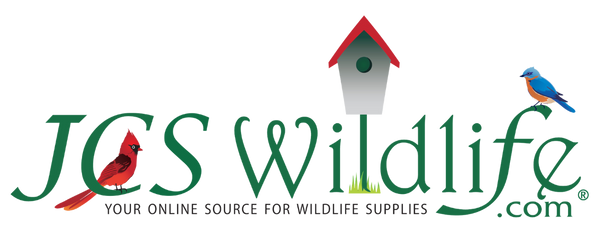
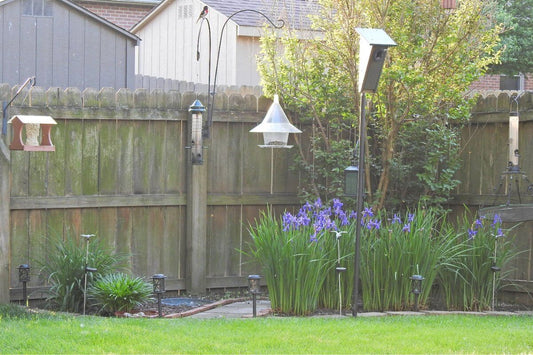
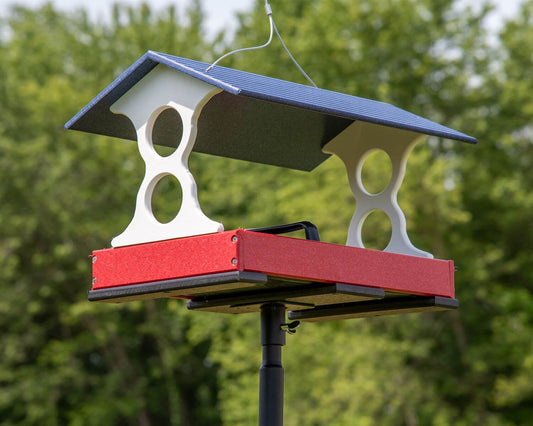
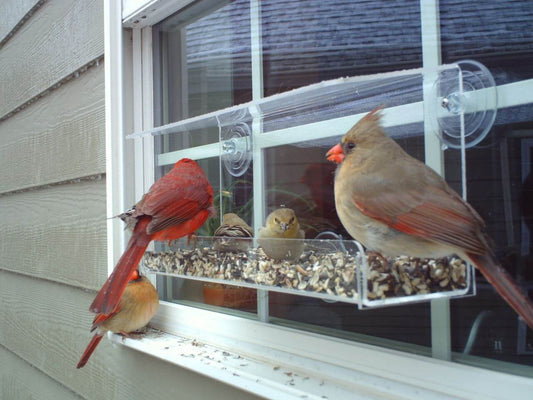














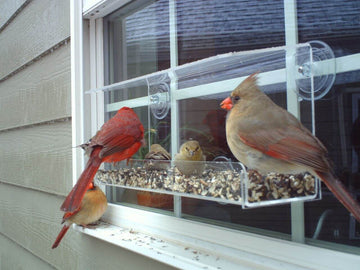
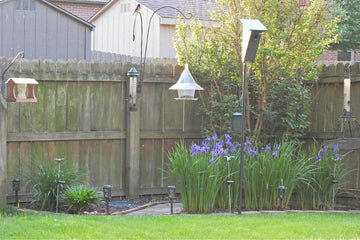

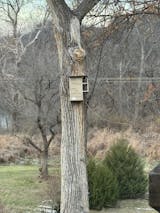
0 comments